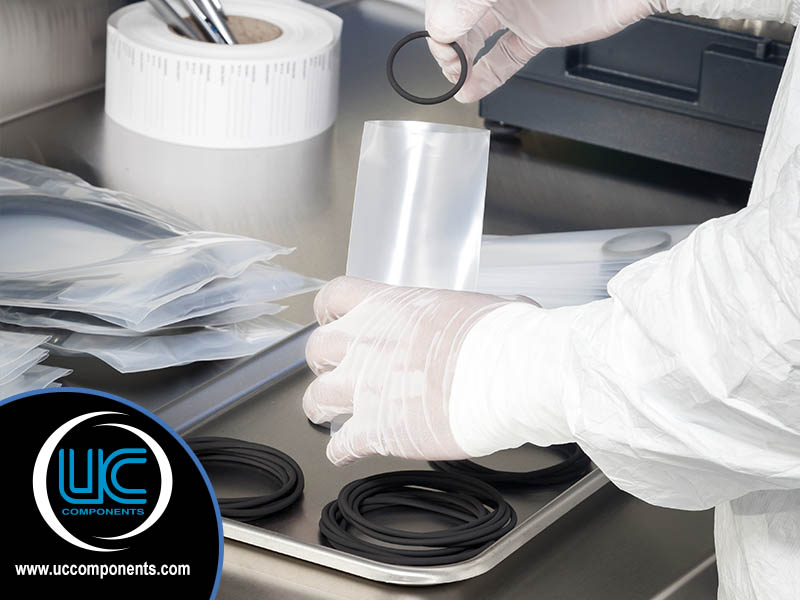Permeation, or the permeability coefficient, of a polymer refers to the volumetric flow of gasses, under controlled conditions, through the material’s surface. Permeability does not equal leakage! Leakage refers to gasses that flow around the seal. Permeation is a fundamental property of elastomers and is often desired to measure the rate of transmission or diffusion of gas through the material.
Permeation of gases through an O-ring varies by material type, material hardness, degree of squeeze, presence or absence of lubrication, size of the O-ring’s cross-section, and the pressure, temperature, and type of gas being sealed.
In general:
- High durometer compounds feature lower diffusion rates.
- Increased seal squeeze (or high pressure) results in decreased permeability.
- Swelling will decrease permeation rates.
- Different gases have different permeability rates.
- Large gas molecules will lower diffusion rates.
- Externally lubricated O-rings can decrease permeability but can result in contamination issues.
- The more a seal is compressed, the greater its resistance to permeability.
- High temperatures increase diffusion and permeation rates.
Permeation Coefficients for Various Polymers
| Material | He | H2 | H2O | N2 | CO2 |
| EPDM | 25-30 | 16-18 | – | 6-7 | 85 |
| FFKM (PFE) | 60-80 | 6-8 | 90-100 | 8-12 | – |
| FKM | 9-22 | 1-2 | 40 | 0.05-0.7 | 5 |
| FKM – Highly Fluorinated | 30 | 3 | – | 2 | – |
| FVMQ | 140 | 80 | – | 40 | 400 |
| KEL-F | – | 0.1 | – | 0.1 | 0.5 |
| Nitrile | 8 | 2.5 | 760 | 0.1 | 25 |
| Polyimide | 1.9 | 0.1 | – | 0.03 | 0.2 |
| PTFE | – | 0.04 | – | 0.14 | 0.12 |
| Silicone | 250 | 75-450 | 8,000 | 200 | 2,000 |
Units above expressed in 10-8 sccm-cm/sec-cm2-atm.
Calculating Permeation Rates
To calculate permeation, the following formula is used: Q = K A (P1 – P2) d
- Q is the permeation rate (cm3/sec)
- K is the permeation coefficient (cm3 cm/sec cm2 atm)
- A is the area (cm2)
- P1 – P2 is the pressure gradient (atm)
- d is the thickness (cm)
For Vacuum Applications
The most commonly used material for O-rings used in vacuum applications is FKM Viton® due to its lower permeation. Additionally, vacuum baking the O-rings further lowers permeation and decreases outgassing. Outgassing is a common problem when creating, or maintaining, a clean high-vacuum environment. High-vacuum environments and high temperatures increase the rate of outgassing due to vapor pressure and an increase in chemical reactions. One of the best ways to help reduce outgassing is the use of specifically formulated and treated O-ring installation – cleaned or vacuum-baked O-rings.
How can UC Components, Inc. help?
UC Components, Inc.’s standard RediVac® O-rings are available in a wide range of standard AS568A inch-measure sizes and are manufactured from top-quality fluoroelastomer materials. Buna, silicone, and other materials are available, and specific chemistries may also be available upon request.
Our O-rings are cleaned and packaged in a certified Class 100/ISO Class 5 Cleanroom, making them suitable for immediate use in most HV, UHV, or EUV applications. Vacuum-baked O-rings are available for reduced outgassing under vacuum. UC Components, Inc. has been the world leader in high vacuum hardware since 1974. We specialize in O-rings and fasteners for High Vacuum, Ultra High Vacuum, and other critical applications. View our parts catalog online to find the components you need, request a quote, or contact us for more assistance or additional information.



